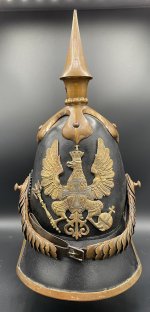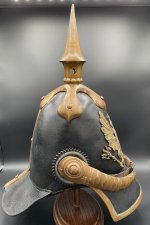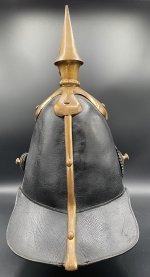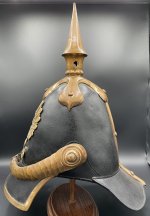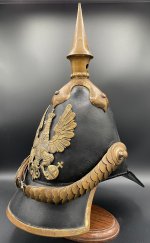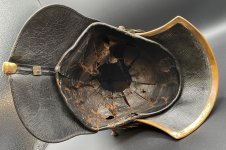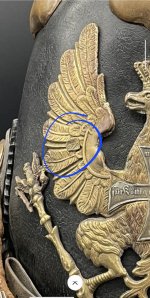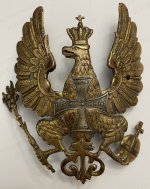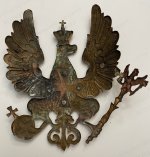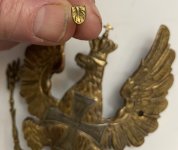You are using an out of date browser. It may not display this or other websites correctly.
You should upgrade or use an alternative browser.
You should upgrade or use an alternative browser.
1842 Prussian Reserve/Landwehr Infantry Helmet - NCO?
- Thread starter cptbob
- Start date
A stunning helmet, congrats!
Amybellars
Well-known member
CLOVIS 57
Well-known member
Yes, in 1842, there was no difference between the ‘Portepee’ non-commissioned officer's roundel and the officer's roundel.It appears to have an officer's cockade so I'm guessing a senior NCO. I like the look of these old-timers.
The finish and superior quality of this helmet confirm that it was a private, commercial purchase (including the square-toothed liner with double holes for the adjustment lace, finer leather than the regulation shells, stitching around the edge of the neck cover, finer edge of the visor, etc.).
Thanks for sharing. Superb and rare.
First off BOB OMG WAY TO GO. If a tiny fairy fluttered in from a forest, and said a collector could have only one Helmet. This is the helmet! I am very happy for you.
Sand cast, no. That is pouring hot metal into a mold flat. Then shaped etc. Here is a good article a few of us wrote about cast Preussen Adler.
Your Preussen Adler above is a two piece cast mould. So crude details on the reverse, but significantly lighter. Very soon after came the beautiful thin die-struck Adler.
This Adler also has a very specific smaller/taller head. Did you notice? Typical 1842 Schwarzenegger biceps, but quite different from the larger head Adler.
Astounding. Way to go Bob!
This is a cast 1842.

Sand cast, no. That is pouring hot metal into a mold flat. Then shaped etc. Here is a good article a few of us wrote about cast Preussen Adler.
Your Preussen Adler above is a two piece cast mould. So crude details on the reverse, but significantly lighter. Very soon after came the beautiful thin die-struck Adler.
This Adler also has a very specific smaller/taller head. Did you notice? Typical 1842 Schwarzenegger biceps, but quite different from the larger head Adler.
Astounding. Way to go Bob!
This is a cast 1842.

Last edited:
southsando
Well-known member
That is one beautiful old helmet!
CLOVIS 57
Well-known member
Totally agree with Tony:
Two ways to "cast" the bronze of this M42 eagle;
---1---Bronze cast in a female mold sculpted in hollow, then compressed by a male mold (in relief). In this case, the obverse is clear, and the reverse a little more blurred, as the "male" press is removed before the metal cools, which cools in the female mold (obverse side).
---2--- Bronze cast in a female mold carved in hollow. The bronze spreads out in the recessed mold and cools. The reverse side (fixing side) is not pressed, and roughly follows the relief of the bottom mold.
In both cases, the thickness of the metal may vary slightly, unlike stamped brass sheet, which always retains the same thickness.
Two ways to "cast" the bronze of this M42 eagle;
---1---Bronze cast in a female mold sculpted in hollow, then compressed by a male mold (in relief). In this case, the obverse is clear, and the reverse a little more blurred, as the "male" press is removed before the metal cools, which cools in the female mold (obverse side).
---2--- Bronze cast in a female mold carved in hollow. The bronze spreads out in the recessed mold and cools. The reverse side (fixing side) is not pressed, and roughly follows the relief of the bottom mold.
In both cases, the thickness of the metal may vary slightly, unlike stamped brass sheet, which always retains the same thickness.
Sandmann
Well-known member
In my opinion this is a molded eagle, not cast. Take a closer look to the edge, the sheet metal has the same thickness everywhere. In addition, some edges with a small radii look crushed by the molding process.
Here is an example of a cast/molded helmet eagle, that Thierry explained in method 1:
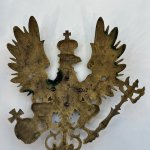
Especially the tail feathers, the orb and the scepter were reduced in thickness by the molding process.
And this is an example of a helmet eagle that was cast only in my eyes (explained by Thierry in method 2):
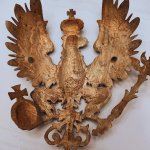
Nearly complete with the same thickness. The scepter, orb and tail feathers are just a block without raised edge.
Here is an example of a cast/molded helmet eagle, that Thierry explained in method 1:

Especially the tail feathers, the orb and the scepter were reduced in thickness by the molding process.
And this is an example of a helmet eagle that was cast only in my eyes (explained by Thierry in method 2):

Nearly complete with the same thickness. The scepter, orb and tail feathers are just a block without raised edge.
Nacuaa
Active member
I agree this is probably one of the most remarkably preserved early helmets I have seen. What a great find. Thank you for the information on casting. These cast or moulded pieces come up occasionally for sale but are dismissed as something commemorative to be mounted on a plaque or something rather than actually fitted to helmets. I'll be paying a lot more attention to these in the future.
CLOVIS 57
Well-known member
Looking at the massive bronze and the thickness of the leather on these (regulation) helmets, it's not surprising that AKO were constantly lightening their models, culminating in the M15 tip helmet, which weighed barely half as much as an M42. Especially with the cupro-aluminium fittings! 

